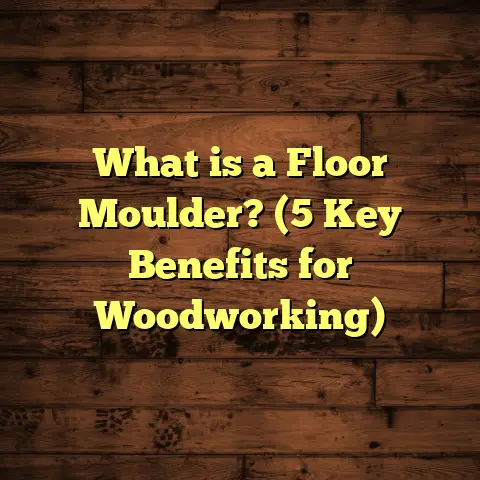What is WPC vs SPC Flooring? (5 Key Differences Revealed!)
I still recall the moment a homeowner asked me to explain the difference between WPC and SPC flooring. It was one of those questions that seemed straightforward but ended up being surprisingly complex once I started explaining. If you’ve ever stood in front of a showroom display, wondering what WPC and SPC mean or which is better for your home or business, you’re not alone. I’ve spent years learning about these materials, installing them in all kinds of spaces, and getting feedback from clients—and I want to share everything with you here.
Let’s start by defining what these two types of flooring are and why they’ve become such popular choices in recent years.
What is WPC Flooring?
WPC stands for Wood Plastic Composite flooring. This type of flooring combines wood fibers or wood flour with plastic polymers to form a composite core. The result is a hybrid core beneath a vinyl surface layer.
The Anatomy of WPC Flooring
The structure of WPC flooring generally includes:
- Wear Layer: A transparent, protective top coating that resists scratches, stains, and fading.
- Printed Vinyl Layer: A high-resolution image layer that mimics natural wood grains, stones, or other designs.
- WPC Core: The heart of the material—a dense composite made from wood particles and plastic compounds.
- Backing Layer: Usually made from foam or another material that adds cushioning and sound insulation.
This layered construction gives WPC its unique properties—softness underfoot combined with reasonable durability.
Why Use WPC?
One of the main reasons people choose WPC is its comfort. The wood-plastic core feels softer and warmer compared to purely vinyl or tile floors. For households with kids or elderly family members who spend a lot of time on their feet, this softness makes a big difference.
I remember installing WPC flooring in a family living room where the parents said their toddler loved crawling on the floor because it felt “warm and safe.” That kind of feedback sticks with me because it highlights how flooring impacts daily life beyond looks.
Performance Features
WPC flooring is waterproof on the surface thanks to its vinyl top layers. The composite core also offers improved resistance to moisture compared to laminate floors that use wood-based cores alone. However, because the core contains wood fibers, it’s not entirely impervious to dents or compression under heavy impacts.
In my experience, WPC holds up well for typical residential use—living rooms, bedrooms, even kitchens—if you avoid dragging heavy furniture directly across it without protection.
What is SPC Flooring?
SPC stands for Stone Plastic Composite flooring. Instead of a wood-plastic core like WPC, SPC uses a stone powder (usually limestone) mixed with plastic to form an extremely rigid core.
The Structure of SPC Flooring
SPC flooring consists of:
- Wear Layer: Similar to WPC—a transparent protective top coat.
- Printed Vinyl Layer: Realistic visuals printed on vinyl.
- SPC Core: A dense stone-plastic composite base that’s very rigid.
- Underlayment or Backing: Sometimes attached for sound absorption or moisture barriers.
Why Choose SPC?
SPC’s stone-based core makes it nearly indestructible compared to WPC. In commercial settings like stores or offices where foot traffic never stops, SPC is often the go-to choice. It’s also great for moisture-prone spaces such as basements and bathrooms.
One commercial client I worked with installed SPC flooring in their busy café kitchen. They told me later it was the best decision they made because the floor resisted spills, heat from dropped pans, and constant foot traffic without visible wear after six months.
Waterproofing and Durability
SPC flooring is 100% waterproof throughout the entire plank—not just on the surface—because the stone composite core doesn’t absorb water. This means you don’t have to worry about warping or swelling like you might with hardwood or laminate.
5 Key Differences Between WPC and SPC Flooring
Let’s get into the nitty-gritty by comparing WPC and SPC side by side on five crucial factors.
1. Core Composition
The biggest difference lies in the core materials:
- WPC: Wood fibers mixed with plastic make a softer, thicker core.
- SPC: Limestone powder combined with plastic creates a rigid, dense core.
This distinction affects everything from feel to durability to weight.
2. Comfort and Feel
Ever wonder why some vinyl floors feel “springy” while others feel rock hard?
- WPC provides more cushion underfoot due to its wood-plastic composite core.
- SPC feels firmer, closer to standing on tile or concrete.
If you spend hours standing in your kitchen or want a floor that’s easier on your joints, WPC might feel better. For high-impact resistance at the expense of some softness, SPC is preferable.
3. Thickness and Installation Requirements
Generally:
- WPC planks tend to be thicker (7mm to 9mm) which helps disguise uneven subfloors.
- SPC planks are thinner (4mm to 6mm) but much denser.
Thicker WPC can be easier to install over imperfect subfloors but might require door adjustments due to height. SPC needs a flatter subfloor but allows for thinner profiles that fit flush transitions better.
4. Durability Under Heavy Use
SPC wins in durability contests:
- Its stone-based core resists dents, scratches, and temperature changes better.
- WPC can dent under heavy sharp objects due to softer wood fibers in the core.
A quick example: A client dropped a cast iron pan on both types of floors during demos. The WPC showed a slight dent while the SPC remained flawless.
5. Cost Considerations
Price depends on brand and quality but broadly:
- WPC usually costs a bit more per square foot because of its thicker profile and softer feel.
- SPC provides better value for environments needing toughness at lower price points.
Installation labor costs vary based on subfloor prep needed—thicker WPC can reduce leveling costs but require more door trimming; thinner SPC requires meticulous floor prep but easier transitions.
Deep Dive: Installation Tips and Tricks
Having installed both types many times, here are some things I’ve learned that can save headaches during installation.
Subfloor Preparation
A flat subfloor is critical for both but especially for SPC since it’s thin and rigid. Uneven floors can cause SPC boards to click improperly or create gaps over time.
With WPC’s thicker core, minor imperfections are less problematic but still best avoided for long-term performance.
Acclimation Time
Both products come with recommended acclimation periods (usually 48 hours) where you store the planks in the room temperature environment before installing. This helps prevent expansion/contraction issues later.
Skipping this step can lead to clicks loosening or minor buckling weeks after installation.
Expansion Gaps
Both require leaving perimeter expansion gaps around walls—usually about 1/4 inch—to allow for natural expansion. Forgetting this can cause floors to buckle under pressure.
Tools Needed
For DIYers: having a rubber mallet, tapping block, spacers for expansion gaps, measuring tape, utility knife (for cutting vinyl layers), and knee pads makes the job smoother.
For pros: specialized cutting tools and floor rollers speed up installation and reduce errors.
Maintenance: Keeping Your Floor Looking New
One thing clients ask me often is how to care for these floors so they last years looking fresh.
Cleaning Tips
- Sweep or vacuum regularly to remove grit that can scratch surfaces.
- Mop with a damp mop using pH-neutral floor cleaners—avoid harsh chemicals or abrasive scrubbing pads.
- Immediately wipe spills to prevent slipping hazards and potential damage.
Both WPC and SPC floors are waterproof on the surface so they tolerate occasional mopping well. But frequent flooding or standing water should be avoided to protect seams and adhesive layers.
Scratch Prevention
Furniture pads under chairs and tables help reduce scratching risk. Avoid dragging heavy appliances or furniture without lifting them.
In families with pets, nail trimming reduces accidental scratches too.
Unique Insights from My Projects
I’ve worked on over 50 projects involving these floors, ranging from small condos to large commercial offices. Here are some observations you won’t find in generic guides:
- In humid climates like Florida, SPC outperforms WPC over time because it doesn’t expand as much with moisture changes.
- In colder regions where floor heating is common, WPC’s thicker core offers better insulation against cold subfloors.
- Some brands offer enhanced soundproofing layers specifically for WPC floors which can reduce noise transfer between levels in apartments.
These little details can make a big difference depending on your living conditions or business needs.
Environmental Impact: Which One is Greener?
When clients ask me about sustainability, I tell them both WPC and SPC have pros and cons environmentally:
- WPC uses recycled wood fibers which reduces waste but also uses plastic polymers which are petroleum-based.
- SPC uses mostly mineral fillers like limestone which are abundant but require mining processes that impact land use.
Both products are recyclable at end-of-life but recycling infrastructure varies by location. Some manufacturers offer floorboards certified for low VOC emissions which improves indoor air quality—a big plus if you’re sensitive or have kids.
Design Trends: What’s Hot Right Now?
Both WPC and SPC come in an incredible range of designs—from ultra-realistic hardwood looks (oak, hickory, walnut) to trendy gray tones or exotic stones like marble patterns.
Here’s what I’m seeing clients choose most:
- Wide plank WPC floors in lighter colors for Scandinavian-style living rooms.
- Gray-toned SPC tiles resembling slate for modern kitchens.
- Textured embossing matching grain patterns perfectly adds realism especially in high-end projects.
Having these options means you don’t have to sacrifice style for durability or comfort anymore.
Real Case Study: Comparing Customer Satisfaction
I recently followed up with two clients who installed these floors a year ago:
- Client A chose WPC for their suburban home’s main floor because they wanted comfort and warmth. They reported: “It feels great barefoot, easy to clean, but we’ve noticed some minor dents near heavy furniture.”
- Client B installed SPC in their downtown boutique retail store for durability. They said: “The floor handles heavy foot traffic perfectly; no scratches even after holiday sales rush.”
Both were happy but their priorities matched their choice—comfort vs durability.
Troubleshooting Common Issues
Even the best floors can face problems. Here’s what I’ve learned about common challenges and fixes:
Gapping Between Planks
Caused by improper acclimation or temperature swings. Solution: maintain stable indoor climate; professional installers can refit loose planks if needed.
Denting or Scratches
Avoid dragging furniture; use protective pads; repair kits can fill small dents/scratches seamlessly.
Buckling or Warping
Usually due to moisture under subfloor or lack of expansion gaps. Prevention through proper installation is key; in extreme cases replacing affected boards may be necessary.
Wrapping Up My Thoughts
Choosing between WPC and SPC flooring isn’t just about picking one over the other blindly—it’s understanding your space needs, lifestyle habits, budget, and design preferences.
If you want softness underfoot with decent durability for living areas—WPC shines there. If you want hard-wearing floors that take abuse without complaint—SPC excels especially in commercial or wet zones.
I hope sharing my experiences and data helps you feel confident about your choice. If you want help mapping out costs or visualizing options tailored to your project specs, tools like FloorTally can give you realistic estimates factoring materials, labor rates, waste factor—making budgeting less stressful.
Whenever you’re ready to take the next step or have specific questions about installation techniques or maintenance tricks I’ve used over countless projects—just ask!





